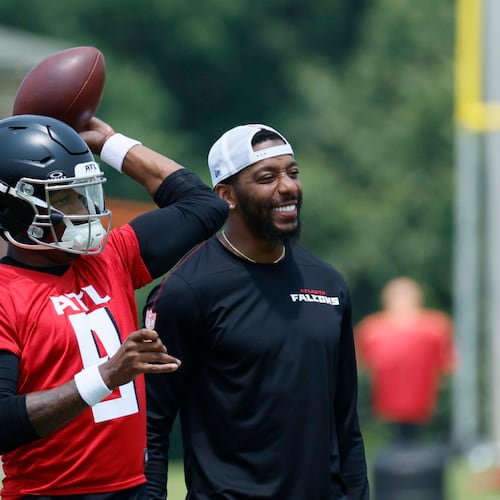Normally, it takes one day, sometimes less than a full day, to prepare Mercedes-Benz Stadium for its next event.
“We can have a football game one day and then convert it to soccer the next,” said Scott Jenkins, the stadium’s general manager.
But getting the building ready for the Super Bowl – the biggest event in U.S. sports – has been a six-week process involving hundreds of contractors and consultants, he said.
The process began in December, when some spaces were emptied to be re-purposed for NFL needs. It continued this month with, to name just a few of the changes, construction of international broadcast booths in the upper deck and operations booths on a skybridge behind the east end zone; conversion of two seating sections into auxiliary press space; installation of lighting trusses all around the stadium for the halftime show; and, perhaps most dramatically, the wrapping of more than 100,000 square feet of exterior walls with Super Bowl graphics.
“I’ve been walking the stadium just about every day because it’s transforming so much,” Steve Cannon, CEO of Falcons owner Arthur Blank’s group of businesses, said in mid-January. “To watch the transformation happen day by day is amazing to see.”
The result is “a stadium that looks like it’s built for the Super Bowl,” Cannon said.
» Read: AJC's complete coverage of the Super Bowl in Atlanta
Super Bowl LIII will cap a high-profile first 17 months of operation for the $1.5 billion stadium, which opened on Aug. 26, 2017. Some 4.3 million fans have attended 83 public events there, including college football’s national championship game, two SEC Championship football games and a Major League Soccer championship match.
But the Super Bowl will bring exposure unlike any of the other events. The expected U.S. television audience of more than 100 million viewers will be more than double the combined audiences for the college football national title game (28.4 million), 2018 SEC Championship game (17.5 million) and MLS Cup (1.8 million).
To prepare the stadium for its biggest event, the NFL brought in a deep roster of consultants and contractors in early January, many of whom work on the Super Bowl year after year. To give them time and space to work, no public event has been held in the stadium since the Chick-fil-A Peach Bowl on Dec. 29.
“We’ve been on or ahead of schedule throughout the process,” Peter O’Reilly, NFL senior vice president of events and club business development, said Monday. “We’re really excited about the way it just pops in there, the way it looks, certainly the exterior. We’re in really good shape in terms of how the stadium lays out. Being set now is important because this week we start to go into halftime rehearsals and pregame rehearsals.”
Credit: Curtis Compton
Credit: Curtis Compton
The changes will reduce the maximum seating capacity by probably a few thousand seats but don’t detract from the stadium’s signature features: the angular exterior, halo-shaped video board and eight-piece retractable roof.
While some of the work has been infrastructure-related — creating new entry gates to expand the security perimeter farther from the stadium, for example — much has been cosmetic. Around the concourses, countless graphics have been replaced with images associated with the Super Bowl and Super Bowl sponsors.
“We do a lot of branding and decor,” said Jon Barker, NFL vice president of event operations and production. “What you see on the outside of the stadium is replicated on the inside as well so the experience for the fan is immersive from the moment they enter all the way through. The color is consistent; the look is consistent; the feel is consistent.”
The changes would have been more extensive if Mercedes-Benz Stadium, like many stadiums, had a lot of fixed signage within the seating bowl. But the stadium’s all-digital advertising within the bowl can be easily reprogrammed from event to event.
Still, changes were required in ways you might not imagine.
For example, the locker rooms. “One thing the NFL wants to do is make sure the accommodations for each team are pretty equal,” Falcons president and CEO Rich McKay said. Since the Falcons’ locker room, which the Rams will use, is more spacious than the visitor’s locker room, which the Patriots will use, that required some adjustment.
The home locker room got a temporary size reduction and a redecoration “so that it is more generic and operationally very similar to the visitor’s locker room,” McKay said.
A waiting room for Falcons’ players families, next to the home locker room, has been turned into an NFL work space full of desks.
Even the 100-yard club on an upper-level concourse — normally “a homage to all things Falcon,” as Cannon put it — got a makeover to fit the Super Bowl. “(The NFL’s) graphics people have been working overtime to paper over just about any vertical and horizontal surface that had any logo attached to it,” Cannon said.
On the field, of course, there will be no indication that the Falcons and Atlanta United normally play in the stadium. The Patriots’ and Rams’ names and logos have been painted in the end zones and along the sidelines, as have the NFL and Super Bowl logos on the field.
One key part of the stadium’s brand won’t have to be altered: Although Hyundai is the NFL’s official auto sponsor, Mercedes-Benz gets to keep its name and logo on the building for Super Bowl Sunday.
About the Author
Keep Reading
The Latest
Featured




